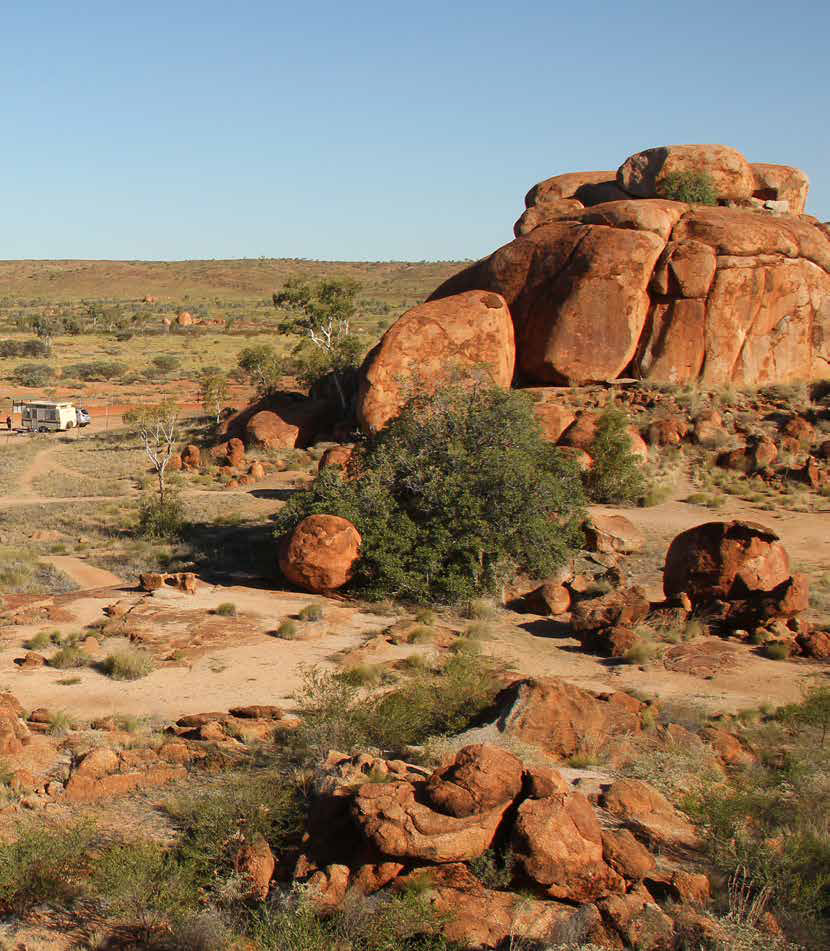
After hundreds of kilometres of outback travel along the Northern Territory’s Stuart Highway, our grandkids were first out of the vehicle as we pulled in to check out some of the Northern Territory’s most unusual rocky outcrops. Seemingly within seconds we found them burning up their pent-up energy, climbing among the rocks and exploring some of the many walking trails that meander among these incredible Top End icons.
Born as coarse-grained granite rock beneath the Earth’s surface more than 1640 million years ago, the NT’s Devils Marbles and Devils Pebbles are steeped in fascination and mystery, and now appeal to both young and old.
The local Aboriginal people say these large spherical-shaped granite rocks are the fossilised eggs of the Rainbow Serpent who once roamed the area. Dreamtime stories of the Serpent can be found in many different locations in northern Australia and today these granite formations remain as real ‘Devil Country’ with mystical fascination.
The Devils Pebbles, scattered over the countryside, 11km north of Tennant Creek and just 6km to the west of the Stuart Highway, are an unusual collection of granite boulders and have long been a sacred Dreamtime site to the local Warumungu Aboriginal women, the ‘Kunjarra’. The granite rocks here, some weighing hundreds of tonnes, are intriguing in shape, colour and formation. They seem to be piled in small heaps as if some giant from the past had picked them up and, with one mighty swipe, left them strewn across a large area of country, waiting to be found millions of years later. Weathering and eroding, they stand tall and defiant against the forces of nature in this unsympathetic hot, dry landscape.
The relentless heat in the central part of the Northern Territory could easily make it Hell on earth – particularly in summer when the temperature is often well above 40°C for days or weeks at a time.
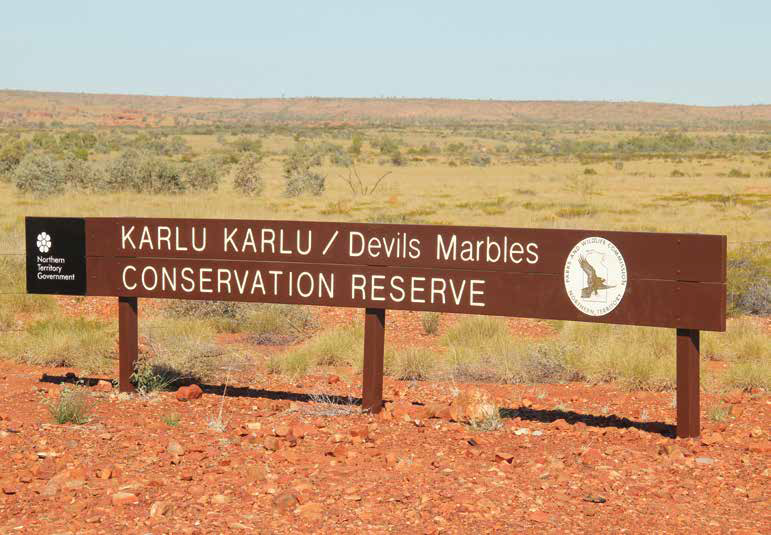
Efficient NT Tourism signs make it impossible to miss them
KARLU KARLU
The Devils Pebbles are a popular picnic spot, offering toilet and barbecue facilities and a basic campground just a short drive from Tennant Creek; visitors can walk through an extensive area of the rock formations.
The Devils Marbles (known to Aboriginal people as ‘Karlu Karlu’, meaning ‘round boulders’), just off the Stuart Highway around 100km south of Tennant Creek and 393km north of Alice Springs, must surely have been one of the Devil’s most significant playgrounds.
Here, he’s not only left his giant marbles scattered around, but he’s left some of them hanging and precariously balanced in a unique and fascinating display. The Marbles, rising out of flat open country, are clearly larger than the pebble formations just over 100km to the north, with a number of giants measuring more than 6m in diameter and weighing several thousand tonnes.
These significant granite formations are seen today as huge rounded boulders which appear to be carefully balanced as separate rocks but geological history tells us they didn’t start out this way. They began as a solid mass of granite formed beneath the Earth’s surface. Erosion over millions of years stripped away the overlaying material and a continual weathering of the granite outcrop has created the shapes we see today. Around the boulders is a colourful carpet of spinifex and red sand, while an occasional wattle or spindly ghost gum adds a contrasting splash of colour to this fascinating landscape. Interesting also is the fact that the bulk of the granite here still remains hidden beneath the earth’s surface.
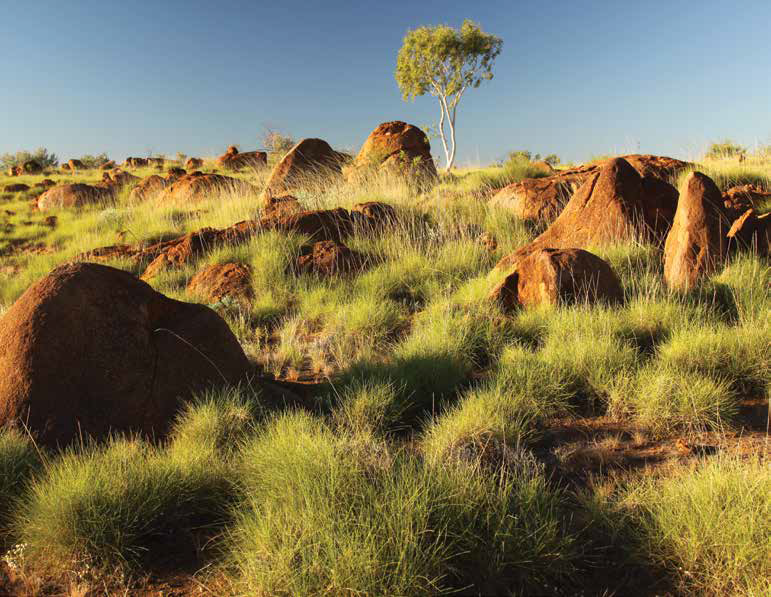
Vegetation softens the harsh rocky ground
PEELING ONIONS
Most of the boulders we now see have a red/brown colouring caused by the oxidation or rusting of iron in the granite’s surface. As wind, rain and sun continually attack the granite’s surface, the boulders suffer a flaking process where layers peel off the rounding shapes like an onion in a weathering action known as exfoliation. In millions of years, those who may be here to study this area will almost certainly find these devilish shapes more eroded and distinctly smaller than they are today.
Several of the boulders can also be seen to be deteriorating in a different way – they are fractured with very fine cracks which allow water to penetrate and attack the interior of the rock. This interior weathering along the cracks often weakens the structure of the boulders until they split apart. This occurs more quickly when the cracks are vertical or nearly so, and the sheer weight of the two halves of the boulders pulls them apart – seemingly almost sliced in two by a giant axe or knife – and still more devilish handwork.
Located just a couple of hundred metres off the Stuart Highway, a sealed roadway leads through the main section to a camping area tucked in behind the formations. In this remote area, it’s a welcome stopover point for travellers heading either north or south through the NT. In the Devils Marbles Conservation Reserve the camping area, a small fee is charged. The area is maintained and patrolled by the local ranger, who keeps the area very clean and tidy. There are several pit toilets, neatly laid-out tables and quite a number of fireplaces with barbecue plates and shady gazebo-style sun shelters provided. Bring your own firewood, water and all supplies. The camping area has been surfaced with a layer of packed river gravel and fenced to prevent vehicles driving among the Marbles themselves.
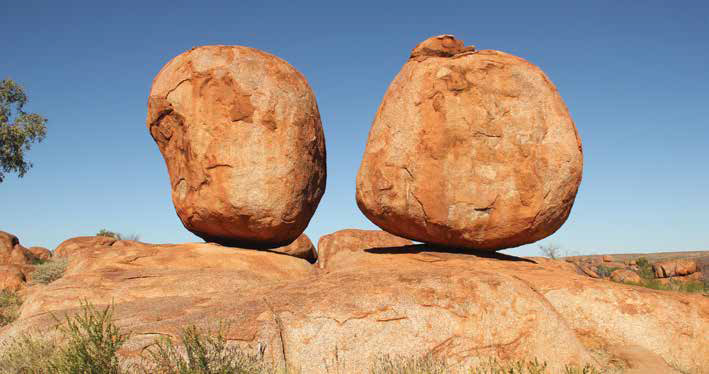
Some of the Marbles look ready to topple at a moment’s notice
Spinifex pigeons and pee-wees are prolific in the area and visit the campsites for any pickings they can find. In and around the granite boulders, delicate fairy martins can be seen swooping and gliding among the formations and their mud nests, built grain by grain with the beaks of these tiny birds, can be seen high in the rocks.
Flocks of other birds including zebra and painted finches, are often found in the reserve. From the camping area or roadway parking areas, visitors are free to walk among the Marbles on a series of informal walking tracks, where signs explain local features and offer historic information on the creation of these fascinating formations.
A walk around both the Devils Pebbles and Marbles is a wonderful experience at any time of the day, but, like many other rocky outcrops, they really come alive at sunset and sunrise – the weathered granite surfaces take on a reflected glow from the sun in the late afternoon and early morning which is bleached out during the middle part of the day. The morning and evening shadows of the boulders give added intrigue to this incredible sight and at night, the eerie silhouettes of these balancing giants is a mystical image that leaves visitors with lasting memories long after they have left Central Australia’s fascinating Devil Country.
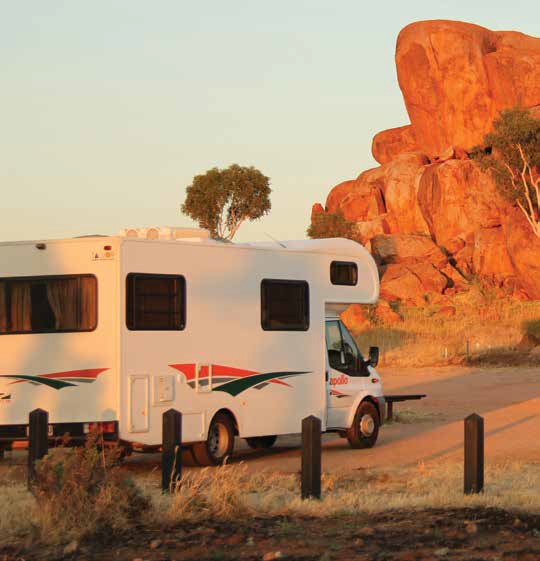
The late afternoon light gives the rock a deep red lustre (perfect for budding photographers)
IN THE DREAMTIME
• Another Aboriginal Dreamtime story on the creation of Karlu Karlu tells of Arranji, the giant Devil man, who travelled through this area. During his journey he was making a hair belt, a ritual item worn by initiated men. Twirling the hair into strings, he dropped clusters of the hair on the ground, which turned into the Karlu Karlu boulders. On his way back, Arranji spat on the ground, creating more boulders.
• At Karlu Karlu (Devils Marbles) in the Dreamtime, traditional owners used this sacred meeting ground for various ceremonies. They came from different parts of the surrounding land to spend time together over three or four weeks of Dreamtime storytelling, dancing and singing praises to the spirit people, so they would bless the land and give the people what they needed.
• The four tribes which came to these gatherings were from the Warlpiri, Warumungu, Kaytetye and Alyawarra people, each performing individual ceremonies. Men and women were divided and when the ceremonies were completed, they came together and waited for the sign that everything was finished before the groups went their separate ways.
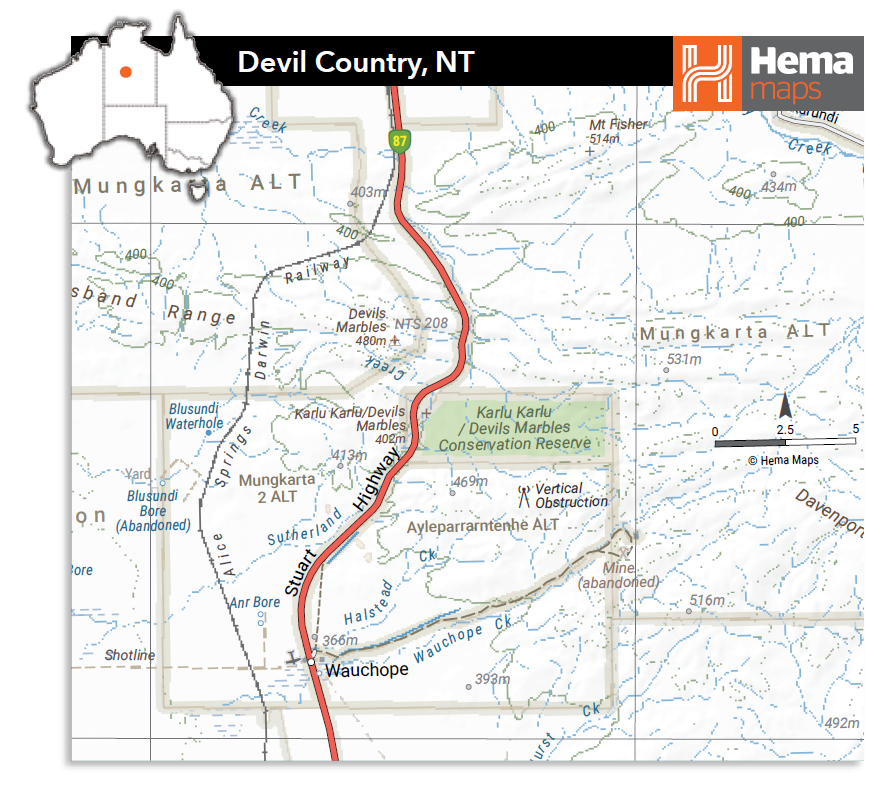
Category: Destinations
Written: Mon 01 Oct 2018
Printed: October, 2018
Published By:
Warurmungu,
Northern Territory
-19.535030960767553 ,
134.18881804221576
GETTING THERE
To reach Devils Pebbles, turn off 11km north of Tennant Creek on the Stuart Highway and travel 6km west to carpark and campground. Devils Marbles is just over 100km south of Tennant Creek. The turn off to carparks and the campground is about 1km behind the granite boulders.
The Devils Marbles Conservation Reserve, spread over 1802 hectares, was handed back to the area’s traditional owners in October 2008. It is leased back to the NT Government so public access may continue. The best time to visit is in the cooler months from April to October as it can be very hot in summer. Arrive by early afternoon, as the campground may fill up. Camping fees apply but are free at Devils Pebbles. All sites are unpowered but generators are not permitted.
MORE INFO
To plan your, visit: www.nt.gov.au/leisure/parks-reserves/find-a-park-to-visit